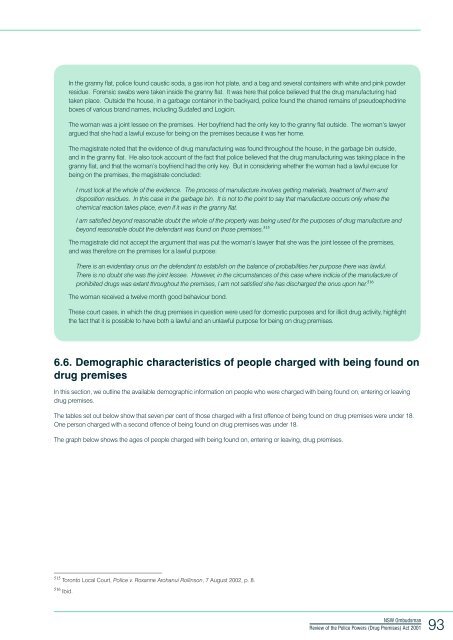Review of the Police Powers (Drug Premises) Act 2001 - NSW ...
Review of the Police Powers (Drug Premises) Act 2001 - NSW ...
Review of the Police Powers (Drug Premises) Act 2001 - NSW ...
You also want an ePaper? Increase the reach of your titles
YUMPU automatically turns print PDFs into web optimized ePapers that Google loves.
In <strong>the</strong> granny flat, police found caustic soda, a gas iron hot plate, and a bag and several containers with white and pink powder<br />
residue. Forensic swabs were taken inside <strong>the</strong> granny flat. It was here that police believed that <strong>the</strong> drug manufacturing had<br />
taken place. Outside <strong>the</strong> house, in a garbage container in <strong>the</strong> backyard, police found <strong>the</strong> charred remains <strong>of</strong> pseudoephedrine<br />
boxes <strong>of</strong> various brand names, including Sudafed and Logicin.<br />
The woman was a joint lessee on <strong>the</strong> premises. Her boyfriend had <strong>the</strong> only key to <strong>the</strong> granny flat outside. The woman’s lawyer<br />
argued that she had a lawful excuse for being on <strong>the</strong> premises because it was her home.<br />
The magistrate noted that <strong>the</strong> evidence <strong>of</strong> drug manufacturing was found throughout <strong>the</strong> house, in <strong>the</strong> garbage bin outside,<br />
and in <strong>the</strong> granny flat. He also took account <strong>of</strong> <strong>the</strong> fact that police believed that <strong>the</strong> drug manufacturing was taking place in <strong>the</strong><br />
granny flat, and that <strong>the</strong> woman’s boyfriend had <strong>the</strong> only key. But in considering whe<strong>the</strong>r <strong>the</strong> woman had a lawful excuse for<br />
being on <strong>the</strong> premises, <strong>the</strong> magistrate concluded:<br />
I must look at <strong>the</strong> whole <strong>of</strong> <strong>the</strong> evidence. The process <strong>of</strong> manufacture involves getting materials, treatment <strong>of</strong> <strong>the</strong>m and<br />
disposition residues. In this case in <strong>the</strong> garbage bin. It is not to <strong>the</strong> point to say that manufacture occurs only where <strong>the</strong><br />
chemical reaction takes place, even if it was in <strong>the</strong> granny flat.<br />
I am satisfied beyond reasonable doubt <strong>the</strong> whole <strong>of</strong> <strong>the</strong> property was being used for <strong>the</strong> purposes <strong>of</strong> drug manufacture and<br />
beyond reasonable doubt <strong>the</strong> defendant was found on those premises. 515<br />
The magistrate did not accept <strong>the</strong> argument that was put <strong>the</strong> woman’s lawyer that she was <strong>the</strong> joint lessee <strong>of</strong> <strong>the</strong> premises,<br />
and was <strong>the</strong>refore on <strong>the</strong> premises for a lawful purpose:<br />
There is an evidentiary onus on <strong>the</strong> defendant to establish on <strong>the</strong> balance <strong>of</strong> probabilities her purpose <strong>the</strong>re was lawful.<br />
There is no doubt she was <strong>the</strong> joint lessee. However, in <strong>the</strong> circumstances <strong>of</strong> this case where indicia <strong>of</strong> <strong>the</strong> manufacture <strong>of</strong><br />
prohibited drugs was extant throughout <strong>the</strong> premises, I am not satisfied she has discharged <strong>the</strong> onus upon her. 516<br />
The woman received a twelve month good behaviour bond.<br />
These court cases, in which <strong>the</strong> drug premises in question were used for domestic purposes and for illicit drug activity, highlight<br />
<strong>the</strong> fact that it is possible to have both a lawful and an unlawful purpose for being on drug premises.<br />
6.6. Demographic characteristics <strong>of</strong> people charged with being found on<br />
drug premises<br />
In this section, we outline <strong>the</strong> available demographic information on people who were charged with being found on, entering or leaving<br />
drug premises.<br />
The tables set out below show that seven per cent <strong>of</strong> those charged with a first <strong>of</strong>fence <strong>of</strong> being found on drug premises were under 18.<br />
One person charged with a second <strong>of</strong>fence <strong>of</strong> being found on drug premises was under 18.<br />
The graph below shows <strong>the</strong> ages <strong>of</strong> people charged with being found on, entering or leaving, drug premises.<br />
515 Toronto Local Court, <strong>Police</strong> v. Roxanne Arohanui Rollinson, 7 August 2002, p. 8.<br />
516 Ibid.<br />
<strong>NSW</strong> Ombudsman<br />
<strong>Review</strong> <strong>of</strong> <strong>the</strong> <strong>Police</strong> <strong>Powers</strong> (<strong>Drug</strong> <strong>Premises</strong>) <strong>Act</strong> <strong>2001</strong> 93
















